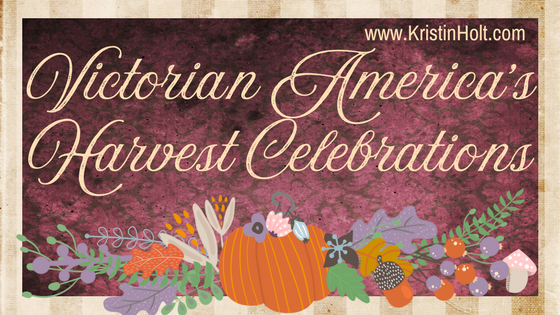
by Kristin Holt | Jan 30, 2018 | Articles
The story behind the invention (development?) of Angel Food Cake is a bit shrouded in tales of “Me, First!” Vintage newspaper advertisements show Angel Food Cake for sale in bakeries by 1878, and in cookbooks for home bakers that same year. One of the origin stories made it into a vintage cookbook (“cook book”), along with minor variations on the fluffy, snow-white theme. No matter how the dessert began, the popularity took off among Victorian bakers and remained popular through the Edwardian and Progressive Era. One peek at Pinterest vouches that this brightly white cake is still popular (even when pink).

by Kristin Holt | Nov 22, 2017 | Articles
Harvest Celebrations from the mid- to latter-half of the 19th century, as reported in newspapers in the United States, show the different types of “Harvest Customs” celebrated. Some customs and words were borrowed from various German immigrants, others were simple gatherings after the work of the harvest with time for thanksgiving and gratitude for adequate (or abundant) food to last until next harvest season.

by Kristin Holt | Aug 10, 2017 | Articles
In Part 2 of this blog series, I share 70 newspaper clippings from Victorian America, wherein reports abound that husbands have sold their wives. Prices range from $0.05 (5 cents) to thousands of dollars (US, Victorian). I provided price comparisons, just for impact. Throughout, I provided my opinions regarding TRUTH or JOKE. Ultimately, there had to be some of both. What a bizarre practice!

by Kristin Holt | Jun 23, 2017 | Articles
The Soda Fountain was a hallmark of late Victorian-era United States culture. Numerous patents and patent renewals show the developments in technology–just how complicated and how effectively simple the designs were. Vintage newspaper articles explain Europe’s reaction to Dows’ Soda Fountain in the American Restaurant at Paris’s Universal Exhibition. Soda fountains have come a long way!

by Kristin Holt | May 13, 2017 | Articles
Despite the voice of reason from scientists of the day, medical doctors, dress reformers, nineteenth century women continued to cling to advertisements claiming health depended upon corsets and laced tightly to achieve the beautiful figure they desired. Advertisements didn’t promote mere beauty–they went so far as to claim health. A newspaper article published in Chicago Daily Tribune of Chicago, Illinois, on April 24, 1897 spoke of Roentgen’s Light–X-rays–and the malformation caused by lacing. Today, the argument seems sound, prudent, and almost laughable that anyone fell for corsets.













